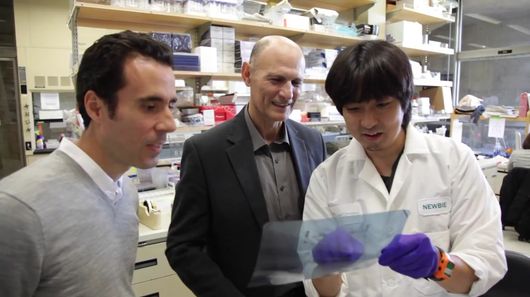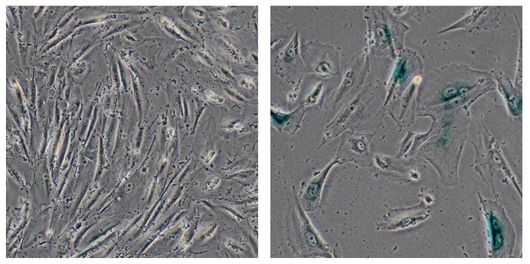A central mechanism of aging identified – and it might be reversible
By Richard Moss
May 6, 2015

Scientists at the Salk Institute and the Chinese Academy of Science have identified what may be the underlying cause of premature-aging disorder Werner syndrome, and with it a possible key to reversing the aging process (Image: Salk Institute for Biological Studies)
Research into the underlying causes of a genetic disorder that causes premature aging and death has revealed a key driver of aging in all people. Better yet, this mechanism is reversible – and with it, perhaps, scientists may be able to slow or reverse the aging process.
People with Werner syndrome age faster than normal because of a genetic mutation that disrupts normal DNA cell processes. It affects around one in every 200,000 people in the United States, with sufferers plagued by early-onset age-related diseases, such as cancer, cataracts, type 2 diabetes, osteoporosis, skin ulcers, and more.
It was previously known Werner syndrome is caused by a mutation to the Werner syndrome RecQ helicase-like gene (WRN for short), and that the normal form of the protein is responsible for maintaining the structure and integrity of a person's DNA. However, it was unclear how this happened.
Scientists at the Salk Institute for Biological Studies, who worked in collaboration with researchers at the Chinese Academy of Science, now have a possible answer. They found a link between the WRN gene and heterochromatin, which is a small, tightly-packed bundle of DNA found in irregular patches inside a cell's nucleus. This bundling serves as a kind of cell switchboard, regulating the complex molecular machinery.

The image on the left shows normal human cells, while the image on the right depicts cells that show signs of aging and that have fallen victim to heterochromatin disorganization (Image: Salk Institute for Biological Studies)
Mutations or deletions of the WRN gene lead to heterochromatin disorganization, which essentially means that anarchy reigns. When connected to the symptoms of Werner syndrome – accelerated aging – this suggests that an accumulation of heterochromatin defects may be an underlying cause of cellular aging. Indeed, the researchers compared heterochromatin levels in six young people, with ages ranging from 7 to 26, and six old people, aged 58-72, and found that the older people showed similar levels of heterochromatin defects to Werner syndrome sufferers.
"This begs the question of whether we can reverse these alterations – like remodelling an old house or car," says study senior author Juan Carlos Izpisua Belmonte. In other words, it may be possible, by reversing the heterochromatin disorganization, to slow or reverse the aging process in humans.
First, however, scientists must explore further how heterochromatin disorganization relates to other cellular factors in aging, such as the shortening of telomeres, which are responsible for protecting chromosomes from damage.
A paper describing the research was published in the journal Science.
You can watch a video that talks about the discovery and its implications below.
Source: Salk Institute
copyright © Gizmag 2003 - 2015
http://www.gizmag.com/central-aging-mechanism-reversible/37340